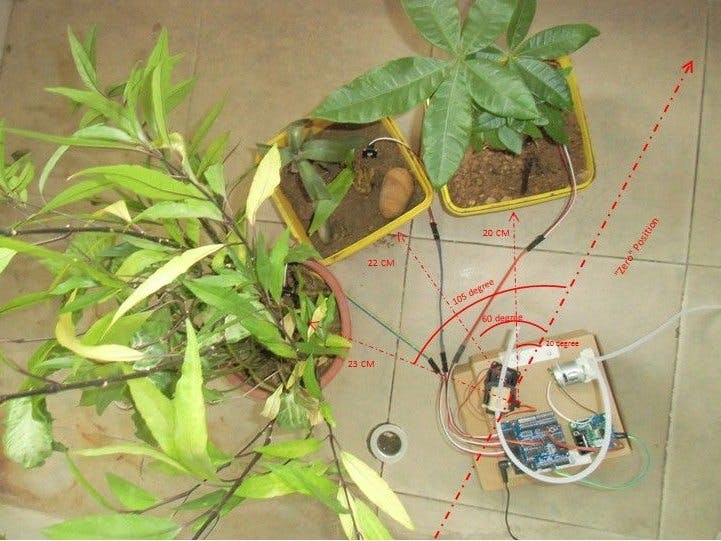Software apps and online services | ||||||
 |
| |||||
By using arduino board to control the irrigation purpose (i,e.,)in a land the moisture is enough or not then the moisture level sensor will sense.Then automatically the motor will ON or OFF by using wifi or bluetooth module in samsung mobile
/*
Automatic watering system
created 26 OCT. 2013
by Elecrow(www.elecrow.com)
*/
#include <Servo.h>
#define triger 250
//Define the parameters of the flower1
#define servoPosition0 20 //the position of the flower1, the range of the servo position is 10~160
#define triggerValue0 135 //the trigger value of the moisture, the minimum value is 0, means the moisture is 0, the soil is very dry. the maximum value is 1024.
#define wateringTime0 35 //the time for watering the flower1, millisecond. delay 35ms, uses about 70ML water
//Define the parameters of the flower2
#define servoPosition1 60 //the position of the flower2
#define triggerValue1 180 //the trigger value of the moisture
#define wateringTime1 20 //the time for watering the flower2,millisecond
//Define the parameters of the flower3
#define servoPosition2 105 //the position of the flower3
#define triggerValue2 200 //the trigger value of the moisture
#define wateringTime2 15 //the time for watering the flower3,millisecond
Servo horizontalServo; // create servo object to control a servo
Servo verticalServo;
//Define the moisture sensor pins
const int analogInPin0 = A0; //
const int analogInPin1 = A1;
const int analogInPin2 = A2;
//the value readed from each moisture sensor
int moistureValue0 = 0;
int moistureValue1 = 0;
int moistureValue2 = 0;
//the sum of the 30 times sampling
long int moistureSum0 = 0; //we need to sampling the moisture 30 times and get its average value, this variable is used to store the sum of the 30 times sampled value
long int moistureSum1 = 0;
long int moistureSum2 = 0;
//Define the water pump contorl pins
const int pumpAnodePin = 6; //pin 6 connect to the anode of the pump
const int pumpCathodePin = 7; //pin 7 connect to the cathode of the pump
void setup()
{
Serial.begin(9600);
horizontalServo.attach(8); // attaches the horizontal servo on pin 8 to the servo object
verticalServo.attach(9); //attaches the vertical servo on pin 9 to the servo object
initPosition();
delay(500);
pinMode(pumpAnodePin, OUTPUT);
pinMode(pumpCathodePin, OUTPUT);
}
void initPosition()//Init the position of the servos
{
verticalServo.write(15);
horizontalServo.write(25);
delay(1000);
}
void loop()
{
delay(1000);
moistureSampling();
if(moistureValue0 < triggerValue0)
{
proWatering(servoPosition0, wateringTime0);
return;
}
if(moistureValue1 < triggerValue1)
{
proWatering(servoPosition1, wateringTime1);
return;
}
if(moistureValue2 < triggerValue2)
{
proWatering(servoPosition2, wateringTime2);
return;
}
}
void moistureSampling()// read the value of the soil moisture
{
for(int i = 0; i < 30; i++)//samping 30 time within 3 seconds
{
moistureSum0 = moistureSum0 + analogRead(analogInPin0);
moistureSum1 = moistureSum1 + analogRead(analogInPin1);
moistureSum2 = moistureSum2 + analogRead(analogInPin2);
delay(100);
}
moistureValue0 = moistureSum0 / 30;//get the average value
moistureValue1 = moistureSum1 / 30;
moistureValue2 = moistureSum2 / 30;
// print the results to the serial monitor:
Serial.print("Moisture0 = " );
Serial.print(moistureValue0);
Serial.print("\t Moisture1 = ");
Serial.print(moistureValue1);
Serial.print("\t Moisture2 = ");
Serial.println(moistureValue2);
Serial.println();
moistureSum0 = 0;//reset the variable
moistureSum1 = 0;
moistureSum2 = 0;
delay(4000); //delay 4 seconds
}
void proWatering(int servoPosition, int wateringTime) //sweep watering
{
horizontalServo.write(servoPosition - 10); // setting the servo to the position of the flower
delay(500); //waiting the servo go to right position
digitalWrite(pumpAnodePin, HIGH); //the pump start working
digitalWrite(pumpCathodePin, LOW);
for(int pos1 = 15; pos1 < 33; pos1 +=6)//
{
verticalServo.write(pos1);
for(pos = servoPosition - 10; pos <= servoPosition + 10; pos += 1) // goes from 0 degrees to 180 degrees //25,160
{ // in steps of 1 degree
horizontalServo.write(pos); // tell servo to go to position in variable 'pos'
delay(wateringTime); // waits for the servo to reach the position
}
verticalServo.write(pos1+3);
for(pos = servoPosition + 10; pos>= servoPosition - 10; pos-=1) // goes from 180 degrees to 0 degrees
{
horizontalServo.write(pos); // tell servo to go to position in variable 'pos'
delay(wateringTime); // waits for the servo to reach the position
}
}
for(int pos1 = 33; pos1 > 15; pos1 -= 6)//
{
verticalServo.write(pos1);
for(pos = servoPosition - 10; pos <= servoPosition + 10; pos += 1) // goes from 0 degrees to 180 degrees //25,160
{ // in steps of 1 degree
horizontalServo.write(pos); // tell servo to go to position in variable 'pos'
delay(wateringTime); // waits 15ms for the servo to reach the position
}
verticalServo.write(pos1-3);
for(pos = servoPosition + 10; pos >= servoPosition -10; pos-=1) // goes from 180 degrees to 0 degrees
{
horizontalServo.write(pos); // tell servo to go to position in variable 'pos'
delay(wateringTime); // waits 15ms for the servo to reach the position
}
}
digitalWrite(pumpAnodePin, LOW);
digitalWrite(pumpCathodePin, LOW);
delay(500);
initPosition();
}
void watering(int servoPosition, int wateringTime)
{
Serial.println(servoPosition);
horizontalServo.write(servoPosition);
delay(1000);
digitalWrite(pumpAnodePin, HIGH);
delay(10000);
digitalWrite(pumpAnodePin, LOW);
delay(3000);
}
/*(void basicWatering(int servoPosition, int wateringTime) //watering in one point
{
Serial.println(servoPosition);
horizontalServo.write(servoPosition);
delay(800);
digitalWrite(pumpAnodePin, HIGH);
delay(wateringTime);
digitalWrite(pumpAnodePin, LOW);
delay(500);
initPosition();
}*/
Thanks to N.Subhalakshmi, P.Rajalakshmi, D.Uma Maheswari, K.Elakkiya, and B.Saraswathi.



Comments